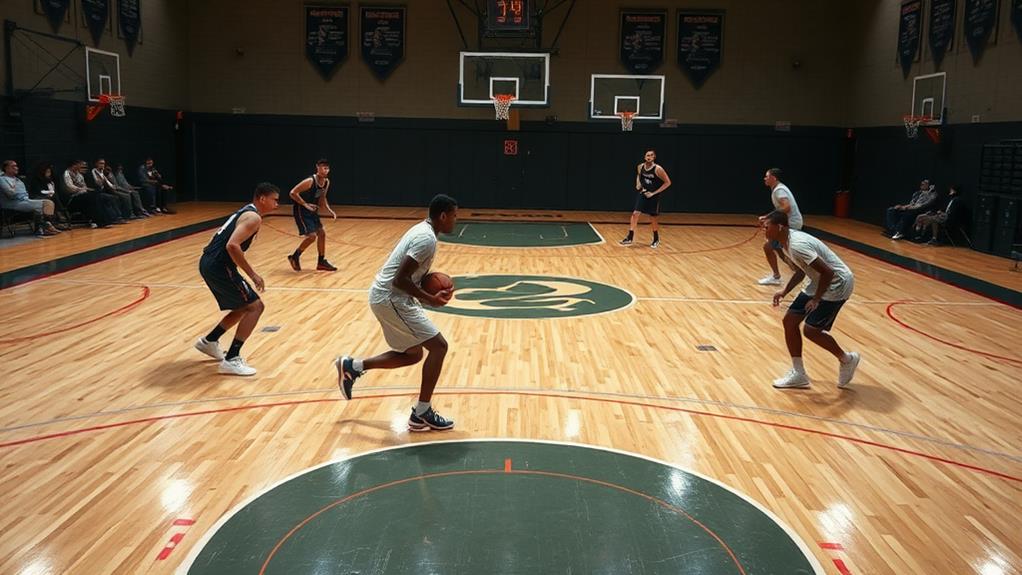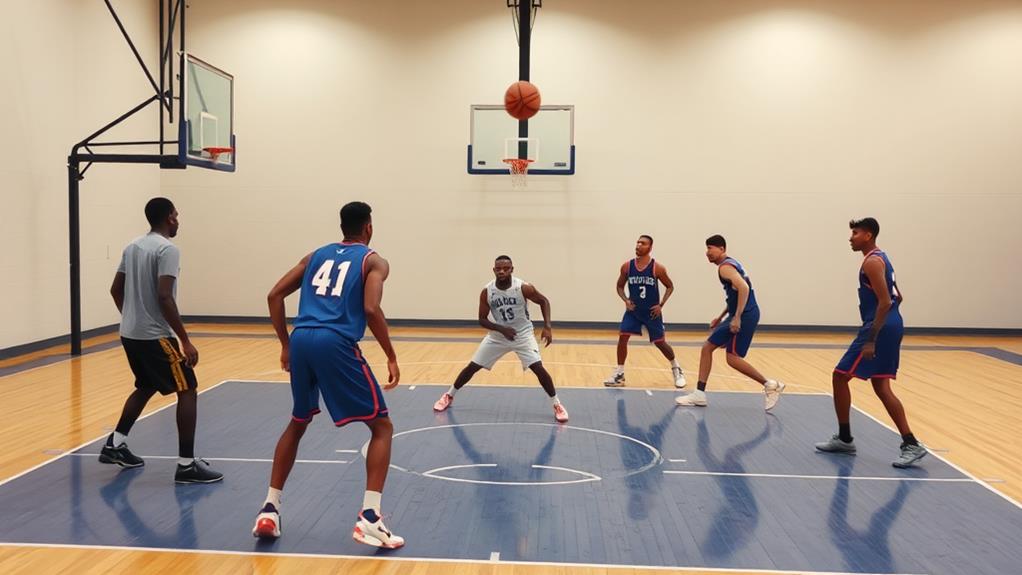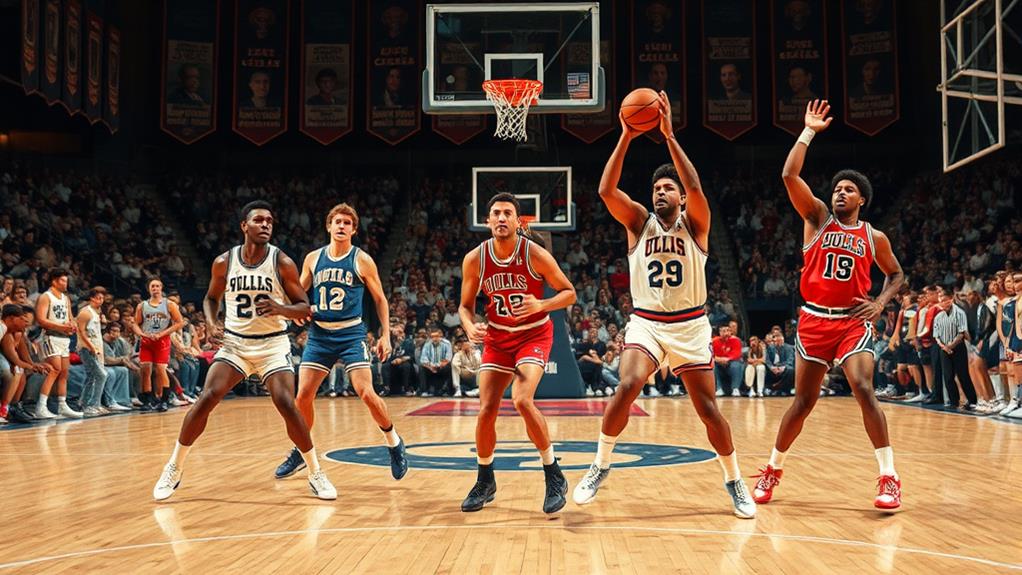
Understanding ISO (Isolation) Play in Basketball
October 2, 2024Understanding ISO play in basketball helps you see how teams create scoring chances by isolating a player against a weaker defender. This offensive strategy focuses on one-on-one matchups, enhancing scoring efficiency, especially in high-pressure situations. By recognizing key moments, like when the shot clock is low, you can leverage isolation to exploit defensive mismatches. Proper court positioning and spacing are essential for success. Mastering techniques like footwork and ball handling strengthens execution. Avoid common mistakes, such as overlooking mismatches. Keep exploring this topic to reveal deeper insights into the effectiveness and impact of isolation plays in the game.
Definition of Isolation Play
Isolation play, often called "iso," is an offensive strategy that sets up one player against a defender for a one-on-one scoring chance. This approach aims to exploit defensive mismatches, targeting a weaker defender or creating a favorable matchup. Typically, a team's best offensive player, often a skilled scorer or playmaker, executes these plays to maximize the scoring opportunity.
By mastering event rules, teams can enhance their iso strategy, creating tailored offensive plays that exploit defensive weaknesses and lead to high-percentage shots efficient play creation.
To run an effective isolation play, you need proper court positioning and spacing. By keeping teammates away, you allow the isolated player to operate freely, minimizing the risk of help defenders interfering. This clear space is essential, as it gives the player a better chance to drive, create their own shot, or utilize their skills effectively.
Isolation plays are particularly valuable in clutch situations or when the shot clock is winding down, emphasizing the importance of strategic timing. By understanding how to set up these plays, you can take advantage of defensive weaknesses and create high-percentage scoring opportunities.
Mastering the execution of isolation play can greatly enhance your team's offensive effectiveness and increase your chances of success on the court.
Benefits of Isolation Strategies
Isolation strategies can greatly boost your team's scoring efficiency by putting the ball in the hands of your best scorers. This approach allows teams to adapt to evolving defensive strategies, especially as historical shifts in defensive approaches reflect changes in offensive tactics.
Scoring Efficiency Boost
By leveraging one-on-one matchups, teams can substantially enhance their scoring efficiency through isolation strategies. Isolation plays allow skilled offensive players to exploit mismatches against weaker defenders, leading to higher percentage shots. In fact, these plays account for about 15-20% of total offensive possessions in the NBA, underscoring their importance in generating points.
Successful isolation plays often result in impressive points per possession (PPP) rates. Elite iso players can achieve well over 1.0 PPP, making them invaluable assets for any team. When you create one-on-one scoring opportunities, you not only increase your chances of scoring but also reduce the likelihood of offensive rebounds for the opposing team, as isolation strategies often lead to quicker shots.
Moreover, isolation plays shine in clutch situations. Teams frequently turn to their top scorers to create and convert high-pressure scoring chances in the game's final minutes. This reliability boosts overall scoring efficiency and can determine the outcome of tight contests.
Exploiting Defensive Weaknesses
One effective way to exploit defensive weaknesses is by targeting mismatches during isolation plays. When you position your isolation player against a less capable defender, you create high-percentage scoring opportunities. This strategy allows top scorers to capitalize on the defensive team's vulnerabilities, increasing offensive efficiency.
By isolating a skilled player, you can't only boost the chances of scoring but also draw fouls, putting pressure on the defensive team. Proper execution of isolation plays can lead to defensive collapses, which opens up additional scoring chances for teammates if the defense shifts to help.
Timing and strategic positioning are essential. If you isolate your player when defenders are fatigued or in foul trouble, you enhance your scoring potential.
Furthermore, creating space on the court can make it harder for the defense to recover and adjust. The right isolation strategy can transform a simple play into an opportunity for success, making it a fundamental tactic in your offensive arsenal.
Creating Mismatched Opportunities
When you effectively create mismatched opportunities on the court, you release the full potential of your offensive strategy. Isolation plays allow you to position an iso player against a defender who's at a disadvantage, whether due to slower foot speed or fatigue. By exploiting these mismatches, you maximize your scoring potential and create high-percentage shot opportunities.
Top offensive players, like James Harden and Kyrie Irving, showcase how effective isolation can be when it comes to high points per possession. Their ability to identify and exploit mismatches allows them to dominate in vital moments, especially late in games when every possession counts.
Moreover, isolation doesn't just benefit the iso player; it can enhance overall offensive efficiency as well. When defenders collapse on the isolated offensive player, it opens up opportunities for teammates, leading to extra passes and high-quality shots.
This strategic spacing can turn a simple iso play into a team-oriented success.
Timing for Effective Isolation

Successfully timing isolation plays can often make the difference between a hard-fought win and a missed opportunity. As an offensive team, you'll want to execute these plays when the score is tied or within single digits, creating high-pressure situations that can lead to quick scoring chances. The impact on offensive strategy is amplified when the shot clock is winding down; isolation plays can minimize offensive rebounds and force a quick decision from the defense.
When facing a fast-paced opponent, effective timing can catch defenders off-guard, allowing your player to seize favorable shooting opportunities. Positioning is key—successful isolation requires players to get into their spots before the defense can react, so keep your movements deliberate and strategic.
You should also consider important moments, such as when a defender is nearing foul trouble or when a key player is in a scoring groove. By recognizing these situations and timing your isolation plays effectively, you greatly enhance your team's offensive effectiveness and increase your chances of capitalizing on critical scoring opportunities.
Setting Up ISO Plays
To set up an ISO play effectively, you need to select the right player who excels at one-on-one situations.
Ideally, this player should have the versatility to stretch the floor, similar to how modern centers do in creating mismatches against defenders.
Position them where they feel comfortable, like on the wing or at the top of the key, while ensuring ideal spacing among teammates.
This way, you create a prime opportunity for that player to exploit their matchup without defensive interference, enhancing the team's scoring potential through effective ball movement and spacing offensive versatility.
Player Selection Criteria
In setting up isolation plays, selecting the right player is essential for success. You want a player to make the most of the opportunity, so prioritize those with strong one-on-one scoring abilities. Look for a skilled isolation scorer who showcases explosiveness and excellent finishing skills, especially in traffic.
Evaluate current matchups on the court. If you spot a height mismatch, consider it a chance for effective post-up opportunities against a less formidable defensive player.
Also, choose a player who consistently excels in isolation situations; their experience can greatly impact the play's success.
Analyze the isolation player's shooting comfort zones, as this will help you determine the best court position for maximizing scoring potential. You'll want to verify they can access their preferred spots without obstruction.
Additionally, consider the strengths of your other players to create ideal spacing, allowing the isolation player to operate freely without interference from off-ball defenders.
Optimal Court Positioning
Ideal court positioning is essential when setting up isolation plays, as it directly influences the effectiveness of the strategy. You want your isolation player, often the primary scorer, positioned in their comfort zone—usually on the wing or near the three-point line. This placement maximizes their scoring potential.
The other four players must maintain peak court positioning to create space, preventing off-ball defenders from offering help. Position your big men low along the baseline and spread your guards out, ensuring that the defensive players are tied up and unable to assist.
Execution of ISO Offenses

Executing ISO offenses effectively hinges on the ball handler's ability to create space while teammates maintain ideal positioning on the court. The execution of an isolation play starts with you, the designated ball handler, reading the defense. You need to determine whether to attack the basket, pull up for a jump shot, or pass to an open teammate if you're double-teamed.
Proper spacing is essential; your teammates should position themselves to prevent defensive help, allowing you to isolate effectively. Consistent effort in practice, as emphasized in soccer, is also important in basketball as players must develop their skills to react fluidly in these situations relentless pursuit of improvement.
Timing is key—players must move and cut in sync with your actions to tie up their defenders, creating more room for you to operate.
When you're in isolation, focus on using specific scoring techniques. Drive to the basket, execute step-back shots, or utilize post-up moves against mismatched defenders.
Key Techniques for Success
Success in isolation play hinges on mastering a few key techniques that can elevate your game. When you effectively combine footwork, ball-handling skills, and quick decision-making, you'll create more scoring opportunities and keep defenders guessing.
Data-driven strategies can also inform your approach to isolation plays, helping you recognize the most effective scoring options based on analytics. Here are some essential techniques to focus on:
- Footwork Mastery: Use triple threat, jabs, pivoting, and rip-throughs to maintain balance and agility.
- Ball-Handling Skills: Develop strong control and precision to navigate around defenders in high-pressure situations.
- Scoring Techniques: Utilize various scoring options, like driving to the basket, pull-up jumpers, or step-back shots, to create separation.
- Quick Decision-Making: Recognize double teams and adapt swiftly, knowing when to shoot or pass to an open teammate.
- Practice Drills: Incorporate drills like "King of the Court" to enhance one-on-one skills, focusing on creating space and beating defenders.
Common Mistakes to Avoid

Many players underestimate the impact of common mistakes in isolation play, which can greatly hinder their effectiveness on the court. One major mistake is failing to recognize mismatches. When you spot a weaker defender, capitalize on that opportunity; missing it can lead to lost scoring chances.
Moreover, understanding diverse playing styles from various regions can enhance your approach to isolation plays, allowing for a more strategic game plan. Embracing such diverse techniques and strategies can lead to improved performance.
Another pitfall is overcrowding the isolation area. If too many players cluster around the ball handler, it disrupts spacing and reduces your team's scoring potential. Effective spacing allows for better driving lanes and shot opportunities.
Ignoring defensive shifts, like double teams, can also be detrimental. When the defense adjusts, be prepared to pass to an open teammate. Turning the ball over or forcing a bad shot only hurts your team.
Additionally, lack of patience can undermine successful execution. Take your time and wait for the right moment to make your move, especially when pressure mounts.
Analyzing ISO Player Performance
Recognizing the mistakes players often make in isolation play sets the stage for understanding how top performers excel in this area. The best ISO players, like James Harden and Kyrie Irving, have mastered the art of creating scoring opportunities through their exceptional skills.
Innovations in offensive strategies have further emphasized the importance of isolation plays in modern basketball. To analyze ISO player performance effectively, consider these key factors:
- Ball-Handling Skills: Great ISO players can create space and evade defenders effortlessly.
- Scoring Efficiency: Players like Harden average over 1.1 points per possession, showcasing their effectiveness.
- Usage Rates: Top isolation players often have usage rates exceeding 30%, indicating their central role in offensive strategies.
- Mismatch Recognition: Successful ISO execution relies on a player's ability to identify and exploit mismatches, as seen with Kevin Durant.
- Impact on Offense: ISO plays account for about 20% of total offensive possessions, highlighting the importance of skilled isolation players.
Historical Impact of ISO Play

How has the isolation play shaped the evolution of basketball strategies over the decades?
Isolation plays have become a cornerstone of NBA offenses since the 1980s, as teams have increasingly leaned on skilled one-on-one scorers. Historical data shows that these plays now account for over 20% of offensive possessions, underscoring their strategic importance.
The rise of data-driven strategies has allowed teams to analyze player performance and optimize their isolation plays for maximum effectiveness. Legendary NBA players like Michael Jordan and Kobe Bryant showcased the effectiveness of iso plays during their championship runs, turning clutch moments into highlight reels. Their success inspired a generation of players to develop their isolation skills.
Today, you see elite isolation players like James Harden and Luka Dončić consistently ranking among the league leaders in points per possession, reflecting the play's impact on scoring efficiency.
The rise of analytics has further emphasized the value of isolation strategies, with teams adapting to exploit mismatches and favorable matchups. This evolution has led to a resurgence of iso-heavy offenses, as coaches recognize the potential for high-scoring opportunities.
Conclusion
In basketball, isolation play is like a spotlight on a solo performer—when executed well, the result can be awe-inspiring. Just think of Michael Jordan, who often dazzled with his ability to create space and score. By understanding the nuances of ISO plays, you can elevate your game and become that standout player. Embrace the art of isolation, avoid common pitfalls, and watch your performance shine on the court like a star in the night sky.


